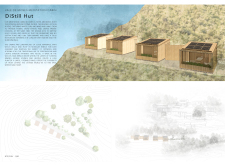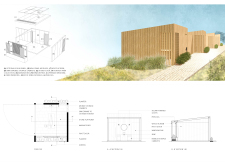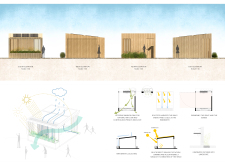5 key facts about this project
The VALE DE MOSES MEDITATION CABIN, known as DiStill Hut, is located in a tranquil natural environment and serves as a space for meditation. The design integrates the surrounding landscape with the goal of creating a balance between the inside and outside worlds. The structure captures important elements like water, sun, and wind, turning them into useful resources that enhance the user experience.
Architecture Concept
The main idea behind the meditation cabin is to act as a bridge between the internal environment and nature. By incorporating elements found in the surrounding landscape, the building makes use of natural resources such as energy and water. The layout is thoughtfully arranged to provide a serene setting where users can engage in self-reflection while being surrounded by nature.
Materiality and Construction
The meditation cabin is built using wood and stone, materials that harmonize with the environment. The wood serves as both walls and roof, providing structural support while giving a warm and inviting appearance. The stone flooring adds a grounding effect and enhances the tactile experience of the interior space. These materials are chosen to promote sustainability and enrich the sensory experience for those using the cabin.
Environmental Integration
A notable feature of the cabin is its approach to managing rainwater. The design includes a system that collects rainwater and channels it through screens, creating a soothing sound that enhances the meditation experience. This system also encourages the growth of plants, contributing to the calming atmosphere. Large operable windows and a significant panel allow for interaction with the outside, making it easy for occupants to connect with nature.
Sensory Experience
The layout employs various openings and screens to filter light and sound. This approach reduces distractions and helps create a peaceful environment. The arrangement of these elements also allows for natural airflow and control over light, giving users the ability to adjust their surroundings to increase comfort. The focus on sensory experience results in a welcoming space designed for relaxation and reflection.
Floor-to-ceiling operable panels frame views of the landscape, further linking the interior of the cabin with the natural world outside. This connection fosters a sense of peace, inviting individuals to immerse themselves in their surrounding environment.






















































